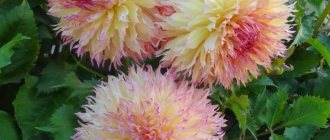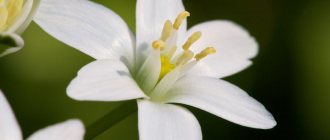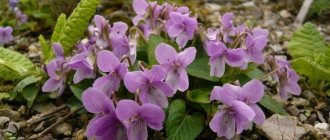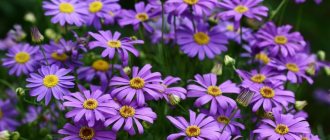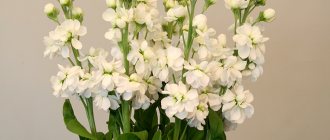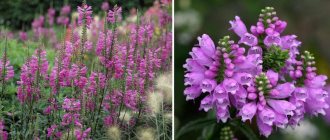The Legend of Dahlias
According to a legend that has survived to this day, the first graceful buds of fluffy flowers appeared on the site of a cooled fire, which was the last to go out during the glacial period of the era. Thus, it became a flower symbolizing the beginning of a new, more comfortable time.
Whether this is true or not is difficult to say. Most likely, the beautiful story was invented to popularize this unusual flower. Although even without mysterious fairy tales, the plant quickly found its admirers, first in Europe, where it came from the colonies, and then throughout the world.
Varieties of perennial dahlias: 30 photos with descriptions
Every year, more and more new varieties of dahlias go on sale, but not all of them are worthy of attention. On my plot, I grow only those samples that have proven themselves over many years in order to select, preserve and distribute the best varieties among gardeners. My collection includes many varieties of old Soviet, Russian, European, Dutch selection and some especially worthy new items.
I have been growing dahlias for more than 30 years and have learned in practice all the secrets of this fascinating activity. To preserve the varietal properties and characteristics of the flower, I propagate dahlias only vegetatively. It is not possible to save the variety by seeds, because... Dahlias are cross-pollinated. For the winter, immediately after the first frost, I dig up the plants and store the dahlia tubers for winter storage. I also want to give a couple more tips that you must follow when caring for dahlias.
1. Tie up dahlias It is advisable to tie up all the dahlias, otherwise gusts of wind easily bend tall plants: the stems and flower stalks are broken, and the bush may die. Therefore, dahlias must be tied up immediately upon planting.
2. Remove faded flower stalks Fading inflorescences must be removed, because seeds have already set in them, they have been pollinated and take over the nutrition of the tubers (after all, the efforts of parents are primarily aimed at raising and raising offspring). Therefore, the flower stalks are removed so that the tubers spend less energy on fully ripening the seeds. If we want the tuber to grow larger, we need to reduce the number of inflorescences on the bush so that the tuber has a larger supply of nutrients. In addition, cutting stimulates the growth of new inflorescences, thus we extend the flowering period and increase the number of flowers.
Red varieties of dahlias
Red varieties of dahlias from my collection include Veltmeister with needle-shaped petals, Vulcan , spherical Zorro . Babylon Red and Spartacus are distinguished by a lush cap of inflorescences. Interesting among the red varieties are fringed Kenora Macob , Paul Robeson with dancing petals. Conventionally, varieties with red inflorescences, but with a contrasting border along the edge can be classified as red: Caballero , Maxim , Manhattan .
Vulcan
An old variety, one of the most interesting among red dahlias. Externally, the variety is similar to Veltmeister, but at the same time it has advantageous differences: it produces strong long peduncles, is very resistant to disease, strong, healthy, suitable for cutting. I have an interesting story connected with Vulcan. There lived in Moscow a breeder known throughout the Soviet Union. Somehow the Vulcan variety disappeared from him, and he asked me to send him this variety to renew the collection. I was flattered by his request and proud that I managed to keep this variety in my possession.
Manhattan Island
A new Dutch variety from the group of decorative dahlias. The plant is medium-sized, up to 90 cm, with flowers from 15 to 20 cm. The color of the pointed petals is bright red with yellow tips.
Babylon Purpur
Dutch tall ornamental variety. Translated, the name of the variety sounds like “Babylon Purple.” The flowers are large, lush, slightly curled, looking like purple caps.
Babylon Red
Continuation of the “Babylon” series in red design. Large inflorescences like sunflowers can reach up to 30 cm in diameter if the plant is well fed.
Needle varieties of dahlias
Needle dahlias, or cactus dahlias, are an original variety with an unusual pointed shape of petals, dissected at the tips. The inflorescences are quite large, double, even “disheveled” and slightly “disheveled”; the plants themselves are tall. Examples of cactus varieties include the bright Exotica , red Veltmeister and Vulcan , the spectacular Kenora Macob , the unusual Paul Robeson , the ornate Tsuki Yori , the spectacular Shooting Star , and the impressive Ambition .
Exotic
Exotic refers to tall needle-shaped dahlias. They are distinguished by the unusual shape of the petals: they are long, narrow, sharp, as if rolled into a tube. Exotica's flower is not large, but beautiful: white with crimson tips, it looks very decorative in a bouquet, there are 5 pieces in a vase - just lovely. I loved him from the moment I first saw him at the exhibition. In honor of this variety, which amazed us so much, we named the flower growers club “Exotica”, led by Tamara Aleksandrovna Mazurina.
Veltmeister
Also refers to tall, needle-shaped varieties. Weltmeiter's inflorescences are quite large and bright red. This variety is old, but one of the best, although it is rather capricious: the tuber does not preserve well in winter. Veltmeister immediately produces long peduncles, so it is very convenient for cutting, which is what it is famous for. I met him more than 30 years ago, when enthusiasts were selling cuttings at the central market. I was lucky - I managed to grow and preserve the variety.
Paul Robson
The chrysanthemum-shaped variety with double inflorescences and dark red velvety petals also has an unusual shape. The old variety is named after an African-American singer who had an enveloping bass voice and sang the song “Wide is my native country” in Russian.
Kenora Macob
The completely unusual shape of the lacy dissected petals gives this American cactus variety a special value. Dark cherry petals, whimsically twisting in the inflorescence, seem to be dancing to exotic motifs. Tall, up to 130 cm, the bush differs from others in the structure and color of its buds. Looks impressive even in single plantings.
Shooting Star
A tall variety with abundant flowering belongs to the group of cactus (needle-shaped) dahlias. Large lemon-colored flowers with a lilac-pinkish tint along the edges. The petals, pointed towards the end, make the variety look like a chrysanthemum.
Tsuki Yori
One of the most spectacular dahlias with a fringed dancing edge. The white, lush, extravagant caps of this tall variety with dense double flowers make Tsuki Yori the center of any composition. The bizarrely shaped petals are more reminiscent of seaweed, set in motion by the gentle play of waves.
Ambition
The medium-sized Dutch variety looks impressive thanks to the dissected shape of bright crimson flowers. The richly colored needle petals make this variety a favorite among other bushes.
Nenekazi
A tall decorative variety, bred in the late 90s. It is distinguished by its unusual color and shape of the inflorescences: pink-yellow petals, fluffed at the very tips, give the flower a special splendor and airiness.
Snowy Rus'
A cactus-like variety of Soviet selection with snow-white, wedding-style inflorescences. One of the few included in the State Register as a variety suitable and recommended for cultivation in the country. The flower caps are so large and heavy that they often break when exposed to wind or rain. Always keep an eye on it, tie it up and cut off the fabulous flowers on time.
Globular varieties of dahlias
Among the interesting spherical varieties in my collection are the red variety Spartacus , Lady Darlene , Tartan , Zorro , etc. The variety that stands out most in this group of dahlias is Pagoda , which has an impeccable ball shape, no matter which way you look at it.
Spartacus
A very decorative variety, distinguished by its original spherical shape and large inflorescence size. The slight corrugation of the petals gives the variety a special value. Do not confuse this variety with another similar in name - Spartak, this is a separate variety.
Tartan
Tall decorative variety. It appeared in my collection about 30 years ago from Moscow breeders. Blooms early, good for cutting, one of the most colorful and attractive varieties. The only drawback is that the tips of the petals burn in the sun.
Lady Darlene
The tall decorative variety amazes with its bright yellow-raspberry color and lush spherical shape of the inflorescences. The petals are slightly wavy and attract the eye with a “delicious” combination of colors.
Zorro
Belongs to the group of decorative dahlias; it grows more than 1 m in height and has large flowers, up to 25 cm. Terry inflorescences of a juicy wine-red color look truly luxurious and will decorate the garden in single and mixed plantings, and a bouquet of such dahlias will not leave any obstinate beauty indifferent!
Pagoda
An unusual, powerful, tall variety with large inflorescences. The elegant white flower has an impeccable spherical shape and looks equally decorative from all sides: back, front, side, top and bottom.
Kelvin Floodlight
Large-flowered, spherical lemon-yellow variety with long flowering. The terry lush bud reaches up to 30 cm in diameter.
Fleurel
The variety is notable for its incredible size of spherical inflorescences. Numerous snow-white curled petals form a heavy, elegant hat, so the dahlia must be tied up and the buds taken care of.
Beautiful varieties of dahlias
The most beautiful varieties of dahlias include decorative double varieties, which are distinguished by the original color of the petals and the shape of the inflorescences. Exotica , Spartacus , Tartan , Nenekazi , Lady Darlene , Bristol stripe , Kids Climax , white lush Snowy Russia, spherical Pagoda , etc. are particularly decorative in my collection
Bristol Stripe
In Russian style, I call this variety Bristol strip. The variety is decorative, tall, with large flowers. The petals seem to have visible veins and stripes that differ in color from the main color. You need to carefully monitor this variety: flowers can cross-pollinate, change color and lose their decorative effect. The petals themselves are pinkish-purple and gently curl and look very playful.
Thomas A. Edison
Decorative frost-resistant unpretentious variety, known since 1929. It has a long, abundant flowering from July to October. It reaches a height of 130 cm. The pleasant purple color of the petals creates an effective contrasting spot in flower arrangements.
Kids Climax
An ornamental New Zealand variety bred in 1940. Lush large inflorescences with delicate yellow-lilac leaves with a bluish tint and slightly curled petals. The plant reaches 110-120 cm in height.
My dream
The flowers of the variety are very delicate, do not stand out with lush caps of inflorescences and bright saturated color, but attract the eye with delicate lilac petals, onto which it seems as if an artist has applied dark purple strokes with a brush. The tips of the petals curl slightly outward, as if reaching out to the hands, which is why the flower looks open and friendly.
Caballero
The bright circus color immediately distinguishes this variety from many others. The glowing red-orange petals look festive. The flowers look good cut, last a long time in a vase and remain fresh.
Color options for the Caballero may differ slightly.
Maxime
Decorative Dutch variety, relatively new, with bright but small (10-15 cm) flowers. Externally, the variety is very similar to Caballero. The same ceremonial red-orange color of the leaves with a sunny border along the edge makes them the center of everyone's attention. The inflorescences, like bright lights, glow both in the flowerbed and in the bouquet.
Rebecca, Rebecca's World
A spectacular variety with variegated contrasting crimson-white petals. In this case, the color of the inflorescences may differ. The petals are either purple with a white border, or white with dark red tips. Thanks to this contrasting combination, when white sugar petals imperceptibly turn into dark raspberry jelly, the variety looks very decorative and elegant.
Festival
Decorative medium-sized variety up to 90 cm high. Valued for the special delicacy of the color of the inflorescences. The petals, pale lemon in the center, gradually acquire a pinkish-lilac hue towards the edges.
Vancouver
A chrysanthemum-shaped, medium-growing Dutch variety, known since the late 90s. The dark purple petals have a delicate cream border that adds playfulness to the lush inflorescences.
Le Baron
Decorative medium-growing Dutch variety. The lush caps of the inflorescences are richly colored lilac. Delicate petals are slightly curled into tubes, which creates a 3D effect, which is why the inflorescences look like a contrasting spot and place the right accents in any compositions and hedges.
Motto
An ornamental Dutch variety with a plant height of up to 100 cm and a flower size of 15-20 cm. The rainbow-colored inflorescences lift your spirits even on the cloudiest day. Yellow-orange petals, slightly curling at the edge, look perky and playful.
Babylon Bronze
Another variety from the Babylon series. Dense inflorescences with orange petals that look like flames will warm you up on cool evenings.
Edinburgh
Decorative tall variety, bred in the middle of the last century in Great Britain. Withstands low temperatures, blooms until late autumn. The purple petals at the tips are painted pure white, as if they had been carefully dipped in white paint. The inflorescences are collected in voluminous balls. Edinburgh planted along the fence will serve as an incredibly beautiful hedge.
Vladimir Mazurin, amateur florist
Orders for these and other varieties of dahlias are accepted by phone. 8-913-940-87-11 (Vladimir Stepanovich Mazurin).
A little history
Perennial dahlias are native to Mexico. They are considered the national symbol of this country and have long been an artifact of the Aztecs.
Mexican legends claim that the luxurious flower lived only in the royal garden for a long time, and only crowned heads could enjoy its charming appearance. But one day a loving gardener stole a blossoming bud and gave it to his bride. The girl was so amazed by the unusual petals and wonderful shades of the flower that she agreed to the marriage. And as a wedding gift she asked for the root of the plant. So the lovely flower got out into the wild.
Dahlias have a second name, little known even to advanced gardeners: Dali. Both names are associated with prominent botanists. In Russia, plants are often named in the feminine gender.
Storing tubers in winter
Low-growing (border) dahlias
Dahlia tubers are sprinkled with sand and stored in a cool, dry place protected from the cold - for example, in a basement. For storing tubers, the optimal relative air humidity is no higher than 60% and a temperature from 3-5 to 7 °C. The room must be well ventilated to prevent mold from forming.
During the winter, the tubers need to be checked from time to time, the rotten parts should be cut off to healthy tissue, the cuts should be sprinkled with charcoal powder and dried in a warm room for 2-3 days.
Many gardeners complain that in warm basements, dahlia tubers often dry out and die. In this case, they should be stored in slightly damp sand. With this storage method, eyes will sprout. This does not cause any particular harm, and sprouts that have reached 10-15 cm should be removed.
Another method of wet storage is as follows. The dug up tubers are washed with water from a hose, and then immersed for several minutes in a solution of potassium permanganate and stored in damp sand. With this storage method, sprouts will also appear, which must be removed periodically.
When to sprout dahlia tubers
Dahlias: planting and care in open ground, description of the 10 most beautiful varieties (100 Photos & Videos) + Reviews
Usage
Most often, perennial and annual dahlias are used as decoration for gardens, alleys, and flower beds.
The varieties of lovely flowers are so diverse that they adorn the exquisite creations of landscape designers, the ordinary flower beds of an ordinary owner of a country house, and even well-groomed flower beds near apartment buildings. Moreover, the question of how to plant dahlias will not become too difficult to resolve.
But the same Aztecs used dahlias as components for medicines, used them as an edible product, and made smoking pipes.
Features of cultivation
These flowers delight us with their dazzling beauty. They do not require special care; even novice gardeners can grow them. There are several ways to propagate this amazing flower. It can be planted by seeds, cuttings, or by dividing tubers.
Any soil is suitable for these plants; they are watered infrequently, but abundantly. Dahlia loves sunny, spacious areas; it also grows well in partial shade. The plant should not be planted in places where there is a draft and there is an excess of moisture. The flower is afraid of cold weather, so planting is carried out when the threat of frost has already passed.
The soil is dug up in the fall, and the soil is well fertilized to provide the future plant with all the necessary nutrients. With the arrival of spring days, the selected area is dug up, and gardeners add bone meal to the soil.
This flower is not grown in areas where asters previously grew. It is also better not to plant them where there are plants that are infected with fungus. Dahlias can also suffer from this disease.
If the time has come for planting, the tubers are divided. To separate, use a knife to separate the tuber. This is a simple and commonly used method of propagation. This operation can be repeated if the size of the planting material allows this. The cut areas are treated with potassium permanganate, brilliant green or crushed coal.
After this, they must be dried. Dry roots are removed using pruning shears; damaged parts should be treated with brilliant green. Then the dahlias are planted in pots or open ground. The distance between holes must be at least 0.5 m.
Planting dahlia directly into the soil is possible if it has completely warmed up. Then the plant will not suffer from the cold. If you purchase a tall variety, you should take care of support in advance.
Kinds
The variety of dahlias is amazing. It is believed that you can decorate any area with different varieties and never repeat them. Flowers have such exquisite colors that they can decorate a garden in any style. Today there are about 15,000 varieties, and breeders continue to breed more and more new species.
Perennial dahlias are the most beloved, although they will require a little more attention to their needs. Similar green decorations are grown from thick roots, which must be removed before winter frosts.
Annual varieties are grown as seedlings. Usually they do not reach large sizes and comfortably frame flower beds and paths. But many gardeners turn annuals into perennial flowers. To do this, their tubers are dug up before the onset of cold weather, and in the spring they are planted again in the ground.
When and how to dig up tubers
In order not to confuse varieties, dahlia tubers need to be labeled
Dahlia tubers are removed from the beds in the fall, after the leaves of the plants turn black from frost. It is better to dig them up in the morning, in dry weather.
Before harvesting, the stems need to be trimmed, leaving about 10-13 cm. When digging up tubers, dahlias should not be held by the remaining part of the stem, so as not to damage the root collar.
The tubers are dug up carefully: on light soils it is better to do this with a pitchfork, and on heavy loamy soils - with a shovel.
The dug up tubers need to be lightly shaken to remove excess soil. They are left in the garden until evening, allowing them to dry. Then, for 7-10 days, the rhizomes are dried in a well-ventilated, dry room. Dried tubers will be stored better.
After drying, the cut stems can be coated with lime solution. This will protect them and the root collar from rotting.
All tubers suspected of having diseases are discarded and destroyed. Damaged, rotten and dead parts are removed. Tubers that received mechanical damage during digging are trimmed and sprinkled with charcoal powder.
Height and varieties
Dahlias can be represented by tall fluffy bushes and very tiny plants.
The most traditional plants have become spherical, peony-shaped, anemone-shaped, pompom-shaped, and needle-shaped flowers.
Dahlias themselves belong to the Aster family. Indeed, many varieties resemble giant traditional autumn flowers. And the flowering time of both species coincides. The best time for the fluffy heads to bloom will be August-September. Although southern neighbors may bloom earlier and last longer in flower beds and lawns.
- Ground cover (creeping) perennials blooming all summer: types, names, photos, description. TOP 10 best options for a summer residence
Clematis flowers - 70 photos of a beautiful flower. Planting, growing and care in open ground
- Astilbe: planting, care. growing from seeds, photos, description of species
When to plant dahlias in spring
In the spring, they start planting dahlias when the ground has warmed up to +10 degrees at a depth of 10-12 cm. The air temperature should not fall below +5. The stems and foliage of the flower are sensitive to cold weather and cannot withstand temperatures below 0.
When to plant dahlias
The time for planting dahlias varies for different regions and depends on the climate and terrain. Even within the same settlement, garden plots in lowlands warm up more slowly, which affects the timing of planting.
| Region | Recommendations for planting |
| Middle zone and Moscow region | Dahlias as tubers or seedlings are planted in mid or late May. If spring is early and the soil has warmed up earlier, you can plant flowers at the beginning of the month, but covering material must be kept at the ready. |
| Ural and Siberia | The earth warms up to a temperature comfortable for flowers only in June. Here, even tuberous dahlias are preferable to growing through seedlings. Can be planted in warm beds a week or more earlier. For reliability, arcs with film or lutrasil are installed above the bed. |
| Southern regions | Dahlias are planted in April, while there is still moisture in the ground. To retain moisture in the soil, the surface of the earth around the bushes is mulched with shavings, peat, and humus. |
Popular annual dahlias of the Merry Guys variety can be sown directly into the ground in places with a warm climate. Sowing is carried out in May, when the weather is warm without sudden temperature fluctuations. The crops are covered with film to create a comfortable temperature for seed germination.
When to plant dahlias in spring according to the lunar calendar 2022
More and more gardeners and gardeners work with plants based on the lunar calendar.
| Month | Better days | Month | Better days |
| January | 10-15, 25-27 | July | – |
| February | 4-12, 19-23, 25-27 | August | 2-6, 8-10, 22-24, 29-31 |
| March | 6, 8, 16, 17, 19, 20, 20-25 | September | 5-7, 13-15, 23-25, 28-30 |
| April | 5-12, 21-22, 25-30 | October | 2-4, 11-15, 20-22 |
| May | 2-5, 10-12,17-22, 27-29 | november | 21-23, 26, 27 |
| June | 1-3, 6-8 | December | 4-6, 14-16 |
In 2022, unfavorable days fall on the following dates:
- January – 2, 3, 17, 18
- February – 1, 2, 16, 28
- March – 1, 2, 18, 27, 28
- April – 1, 2, 16, 23
- May – 1, 16, 30
- June -14, 18, 29
- July – 13, 14, 28, 29
- August – 11, 12, 27-28
- September: 9-10, 26, 27
- October: 9, 10, 25, 26
- November: 1, 2, 7-9, 24, 25, 28, 29
- December: 7-9, 23-25
Landing
Graceful and somewhat austere flowers emerge from dahlia tubers. Planting begins in late spring or early summer, when the threat of frost has passed and the soil becomes warm not only on the surface, but also at a shallow depth.
When planting nodules, special attention is paid to the growth points of the plant. They must be above the ground. Otherwise, the tiny shoots may begin to rot.
- Pelargonium in open ground: planting, growing, care, reproduction, photo
Marigolds: planting, growing, care and propagation in open ground. Overview of all types and varieties of marigold flowers
- Flower seedlings - ideas, selection features and secrets of placing seedlings of annual and perennial plants
Some gardeners prefer to germinate flowers in a thick layer of sawdust covered with plastic film. In this case, it is necessary to monitor the humidity of the tubers and the access to fresh air.
When planting in early spring, future plants must be covered with covering material.
Caring for dahlias
Watering dahlias
Caring for dahlias after planting in open ground during the growing season is as follows:
- As soon as the shoots reach 30-40 cm, they need to be tied to stakes
- In order for the stems to be stable and the inflorescences to be large, usually no more than 2-3 shoots are left, and the excess ones should be removed
- In many varieties, stepsons are formed in the leaf axils. They need to be pinched at the very beginning of development (pinching)
- Fading lower leaves of plants are cut off
- The lateral buds of the flowering shoot are also removed.
- Further care comes down to weed control, loosening the soil, watering and fertilizing
- It is useful to mulch the soil under dahlias using humus as mulch. In this case, it is enough to water the plants once a week at the rate of one bucket of water per bush
- After the plants bloom, the watering rate should be increased.
- Feeding is a necessary part of caring for dahlias after planting. The first feeding of plants is given a month after planting in the ground. It is especially needed during budding. Dahlias should be fed with organic or mineral fertilizers 1-2 times a month.
- In autumn, it is recommended to protect dahlias from the first frosts with a smoke screen. Thanks to this technique, the plants will continue to bloom until the end of October.
- Dahlias are demanding on soil and air moisture. The soil must be constantly kept moist, avoiding drying out and waterlogging.
- On a hot summer day, moisturizing watering is carried out using a sprinkler or special nozzles. This allows you to increase the air humidity for a short time
- At the end of August - beginning of September, the plants are covered with soil to a depth of 12-15 cm. This protects the bases of the stems from possible damage by low temperatures during frosts
- In varieties with powerful development of the vegetative mass, the lower leaves are plucked off at a level of 30-40 cm. This technique improves air exchange around the plants and prevents the growth of a thick stem at the base of the root collar, which impairs the storage of tubers
Watering
Humidity will become almost the only requirement when deciding how to plant dahlias.
Seedlings and tubers will require a drainage layer of gravel, brick, and pebbles to remove excess moisture. After each rain, it is better to loosen the soil so that the water does not stagnate.
- Flower clocks - designer tips, methods of use and original ideas for flower clocks (105 photos + video)
- Low-growing flowers - types, descriptions and ideas for use in landscape design (100 photos and videos)
Flowers for a flower bed - basic design rules and ideas for creating the perfect flower garden (110 photos and videos)
Watering must be moderate so that the tubers do not rot.
Botanical characteristics and varieties of garden flowers
Dahlia is a herbaceous root-tuberous plant that grows as a perennial in its homeland in Mexico. In our climate, it is forced to pause the growing season with the onset of cold weather, but thanks to storage roots (tubers), it persists until spring and is renewed.
Description and structure of the plant
In nature, it is a lush, densely leafy bush 2–2.5 m high, although there are also low-growing species (up to 30 cm), which form the basis of modern dwarf varieties. The stems of the plant are large, but hollow, therefore quite fragile, they break not only from the wind, but also under the weight of their own weight. The leaves are juicy, dark green, dissected. An inflorescence is a basket consisting of two types of petals: reed petals, located in one or several rows along the contour of the flower, and tubular petals in the center.
The dahlia reproduces vegetatively; this is the only way the maternal characteristics of the plant are fully preserved. She does this with the help of a root tuber, which consists of the following parts.
- Thin feeding roots - they die off during storage, and new ones grow after planting.
- Storage roots (tubers) - a storehouse of moisture and nutrition necessary for the plant to survive during the dormant period.
- Root collar – the lower part of the stem to which the tubers are attached. This is where all the growth points are located; there are no buds on the tubers.
Annual and life cycle
The annual cycle of the perennial dahlia is divided into two periods - vegetation and dormancy, and the latter is vital, since at this time the laying of new growth and generative buds occurs. In the warm climate of their natural habitat, the tubers remain in the ground; in our country, they overwinter in the basement, but the processes in them are the same.
The dormant period lasts several months, after which growth buds appear on the root collar. Even if the tubers are not lifted from storage in time, they will still germinate, but the shoots will be pale and elongated. That is why in March-April it is recommended to take out the tubers and germinate them in the light.
The growing season lasts from the awakening of the buds until the complete death of the green mass in the fall. Even if you grow a dahlia in a container, it is not enough to bring it indoors; the tops need to be cut off to allow the tubers to “gather strength” for the new season.
The productive life cycle of the perennial dahlia is 3–4 years. If the root tuber is not divided, it ages and dies after 4–6 years. You can determine that a tuber is old by a sharp decrease in the number of flowers and excessive thickening of the bush.
Advice! When dividing a root tuber, it is important that each division consists of 1–2 thick storage roots (nodules) and a piece of root collar with 2–3 growth buds. You can start dividing only after the growth points have swollen and are clearly visible.
Diseases
Gray rot is considered the most common nuisance; it appears as a result of excessive watering or excess nitrogen.
Symptoms of the development of the disease will be a gray coating on the buds, crooked flowers or brown spots. Effective treatment will be rapid removal of the affected areas.
The second disease is fusarium and white rot. High-quality culling of roots before planting, timely and rather ruthless removal of diseased plants will help to avoid such problems.
Decorative
Vancouver
| |
Tartan (Tartan)
| |
Lady Darlene (Lady Darlene)
|
Site selection
To provide dahlias with good conditions for growth and flowering, you need to take into account a number of requirements when choosing a location:
- Calmness. Dahlias do not tolerate drafts. Whatever the wind, it will not bring any benefit: the northern one (especially at low temperatures) contributes to frostbite of the leaves, and the dry southern one burns them.
Dahlias do not tolerate drafts
Advice! Surround the dahlias with trees or plant them behind a fence. However, keep in mind that the shadow from the crowns should not fall on the flowers, otherwise you will not be able to get viable tubers!
Dahlias need moderate lighting
- Flat terrain. Dahlias grow poorly in depressions due to the cold and humidity that settles there. In the south, flowers can be planted on the northwestern slope, and in the middle zone - on the southeastern slope.
- If the groundwater is close (60-70 cm), dahlia bed In the southern regions, on the contrary, they make a hole, which is filled with water overnight.
Beautiful bright orange dahlias
- Before planting, the soil is fertilized with organic matter (manure, compost, humus). Peat and clay are added to dry sandy soils, and sand, gravel and ash are added to heavy clay soils.
- Dahlias tolerate acidic soil, but grow better in neutral soil. Liming will help reduce acid levels.
Among the luxurious assortment of dahlias you can find amazing specimens of the most incredible shapes and colors
The planting procedure is carried out in the spring. They dig a hole, focusing on the size of the tuber and taking into account the volume of added fertilizers (manure, compost, etc.). When placing a seedling in a hole, make sure that the root collar rises above the ground level.
To speed up flowering, dahlia tubers are pre-germinated by keeping them in sawdust under polyethylene and constantly sprayed with water.
Planting dahlias
Advice! To avoid damaging the rhizome in the future, provide supports for the stems during planting.
